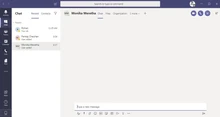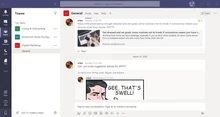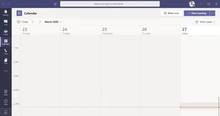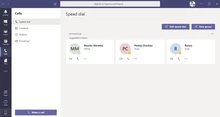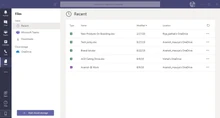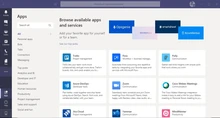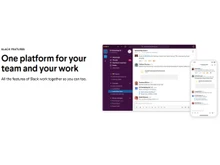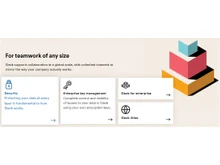Chat-based collaboration platforms have become a necessity in today's modern business environment, with Microsoft Teams and Slack emerging as the two-industry leading business communication platforms.
Both these platforms have a lot of things in common, but since the pandemic, both these companies are consistently adding new features and functions to their repertoire to become the best collaboration tool in the market. That's great news for their users, but this causes a lot of problems when it comes to choosing one between these two. Here, we'll dig into some noteworthy differentiators, so you can take a decision based on your requirements and preferences.
Microsoft Teams vs Slack – Overview
The primary difference between Teams and Slack is their purpose. While Teams is a collaboration based software that emphasizes chat, document management and video conferencing, Slack is a workplace chat-based tool that focuses on communication. Teams is an integral component of the Microsoft ecosystem offering a gamut of premium features. On the other hand, Slack is owned by Salesforce and comes with a wide range of comprehensive third-party integrations.
Microsoft Teams also offers a host of useful integrations for cloud storage and file sharing. This platform excels in hosting large events and live video conferences. Meanwhile, the strength of Slack lies in its flexibility. It is considered one of the most user-friendly messaging apps because of its ability to adapt to almost all situations. For companies that have employees working from multiple locations, Slack allows them to stay connected, collaborate and share important docs. Both Teams and Slack require no learning curve and they are equally beneficial for communication among internal teams and video meetings with clients and vendors.
Microsoft Teams vs Slack – Difference in Terms of Pros & Cons
- Slack has a sleek user interface and provides an easy onboarding procedure with a step-by-step tutorial for users. Teams has followed Slack's example and has the same type of User Interface (UI), but without Slack's useful interactive step-by-step onboarding guide.
- Slack's user interface is more customizable and allows you to create custom themes and select a sidebar color. In contrast, Microsoft only offers a 'high contrast' theme as the third option. You can try using the high contrast theme if the text and other elements on your screen appear blurry or if you think there is too much white backdrop and if you work in an area that has very bright lighting or glare.
- Teams offers guest access and screen sharing facility for free, while on Slack these features are only available in paid plans.
- 1:1 video and voice calls are offered in the free version of Slack and if you want to organize a group video call with up to 15 callers simultaneously then you need to upgrade to the paid plan. Teams boast of far superior video conferencing capabilities, with the free version offering the facility to host 300 people at the same time.
- Slack has productivity hacks like setting task reminders, bookmarking your important messages, customizing the notifications settings, and more. You also get keywords shortcuts for almost everything to boost your productivity and it can be integrated with some popular task management platforms like Pipefy and Trello. In contrast, Team's productivity shortcuts are less organized and useful than Slack.
- With Slack you get advanced search options, for example, you can find messages with emojis. It is a great feature if your staff uses a particular emoji to depict priority messages or identify closed deals. Microsoft Teams comes with slightly more advanced search options, with the ability to sort the search results by dates.
- Slack comes with a shared channel attribute, which makes it extremely easy for you to connect with an external stakeholder's Slack workspace. But, in Teams, it's difficult to chat with anyone outside your company as you have to add guest access or external access for outside parties. After that, it lets you communicate via video or voice chat or set up online meetings.
Microsoft Teams vs Slack — Differentiating Features
| Features |
Microsoft Teams (O365 or M365 plan) |
Slack (Paid Plans) |
| Max users supported per org |
300 - Unlimited |
Unlimited |
| Max teams/workspaces per org |
Unlimited |
1 (Pro, Business+); Unlimited (Enterprise Grid) |
| Max channels per team/workspace |
200 standard channels & 30 private channels |
Unlimited |
| Number of supported languages |
53 |
8 |
| Maximum number of users supported per channel |
10,000 for standard channels and 250 for private channels |
100,000+ |
| Apps available for |
Windows, macOS, Linux, Android, iOS, web |
Windows, macOS, Linux (beta), Android, iOS, web |
| Searchable messages |
Unlimited |
Unlimited |
| Storage |
Yes |
Yes |
| Private and public channels |
Yes |
Yes |
| Guest access |
Yes |
Yes |
| Shared channels with partner organizations |
Yes |
Yes |
| Call recording and transcriptions |
Yes, you can upload to SharePoint Online or OneDrive for Business |
Yes, with Zoom and other integration |
| Customizable notifications |
Yes |
Yes |
| Direct messages |
Yes |
Yes |
| Threaded messages |
Yes |
Yes |
| Voice and video calls |
Yes |
Yes |
| Screen sharing |
Yes |
Yes |
There are so many similarities and differences in the features, but in reality, you might get a similar kind of experience with both the platforms. Let's dive in and uncover some noteworthy features.
- In-app help: In Teams, you get a 'Help' option at the bottom of the sidebar as well as links to training, topics, and everything new in the tool. Every tab is perfectly organized, providing easy to access help content that can be found via the search option. Meanwhile Slack has an app chatbot that is extremely simple to use. You just have to type a keyword or your question in the search box, you'll get your answer within a few seconds.
- Trouble free navigation: Both the Teams’ and Slack’s desktop versions have easy to navigate interfaces, with messaging as the primary focus. You'll get a disorganized feel on Slack, which might be a bit chaotic for some, and Teams have a corporate look and appeal that looks generic and more streamlined.
- Customization: Thanks to the customization option in Slack, you can modify the sidebar's look and appearance in a wide variety of ways. It allows you to tweak the sorting function, inclusion of direct messages and so on. In comparison, Teams only offers three different customization options: high contrast, dark and default (light).
- Guest Access: In the paid plans of Microsoft Teams, you get access for 5 people per account whereas in Slack the paid plans allow unlimited collaboration with all external users.
- Integration: Microsoft Teams lets you choose from 472 apps for integration, on the other hand, Slack allows up to 10 integrations for free plans and with more than 2000+ apps in paid plans.
- Attendance Tracking: Teams offers special capabilities that are specifically designed to assist workers who manage service & task-related duties in travel, manufacturing, hospitality and retail. The unique feature makes it easy for them to clock in or clock out from their mobile phones, share their location or perform other work-related tasks. However, Slack offers the same with integrations like AttendanceBot that manages time tracking, lunch breaks, hourly bills and shift plans of first line workers.
- Message Translation: Teams allows you to translate any message in 36 languages, which helps in seamless communication with staff or stakeholders from other corners of the world. On the other hand, Slack has a slightly different approach here as it integrates with Rozetta Translator bot and many other similar bots for translation.
- Information Sharing: Slack lets you gather information from team members via app integrations, like Guru, a highly effective bot for capturing or sharing information. In contrast, Teams has an integrated Wiki attribute, which helps in gathering and sharing a plethora of knowledge among staff members.
Slack vs. Teams: Mobile & Web Apps
Some desktop programs reduce their features and functionalities on their mobile or web OS versions. But that's not the case with Slack or Teams as both these platforms work as well as their desktop versions. Their mobile app versions have wonderfully replicated the shamelessness and functionalities of the desktop experience.
Moreover, you don't have to do things differently on the mobile versions. However, In order to suit a smaller, touch-enabled mobile device screen, there are certain interface modifications. All in all, in this category both Teams and Slack have done a commendable job of keeping a uniform look and experience across devices.
Moreover, thanks to the Android and iOS versions of these tools, you can easily keep up with the conversation on your mobile phones. You just have to go to Playstore or Apple Store to download the app. Moreover, both Slack and Teams are also available for download for the Windows, Mac, and Linux operating systems.
Microsoft Teams Vs Slack : Messaging & Chat
Both Slack and Teams give you text formatting features for writing messages, but Teams offers a more word-processing-like experience. This means users can incorporate tables, choose from three font sizes, change paragraph styles, undo and redo their work, and more.
However, you get the option to add Emojis in both tools. Teams lets you share emojis through your workspace and you also get native options, such as integration with GIPHY for animated GIFs. Similarly, in Slack, you can upload animated images & emojis through your workspace plus it also allows integration with Reverly, GIPHY, and similar applications.
In addition, Slack allows you to use most audio and video chat functionalities after integrations with Hangouts, Google, Webex, Zoom and more. In Teams, videoconferencing is already an in-built feature, but you also have access to a wide range of other attributes, such as the capability to call people outside your company via Microsoft's cloud-based Phone System. Moreover, you may also record video conversations and calls or obtain transcriptions.
Microsoft Teams Vs Slack: Notification
Teams allows you to customize the notifications you receive for replies, chats, likes, voicemails, missed calls, reactions, mentions and so on. You get the option to choose how you'd like to get these notifications, via email or banner in your desktop app.
Moreover, the desktop app also allows you to preview messages. You don't get the same number of notification options on Slack, but instead, you get the ability to utilize distinct notification settings for your desktop and mobile devices. In addition, you also get notified when someone uses the specified keyword.
Slack excels in the Do Not Disturb (DND) controls, where you can choose to turn off incoming notifications for a specific amount of time, such as 30 minutes, one hour, two hours, tomorrow or the following week. You also get the option of setting a notification schedule, which lets you receive notifications during designated hours and days. However, Teams allows you to set quiet hours during which all alerts are muted, as well as quiet days, plus all these restrictions are only available on the mobile application.
Microsoft Teams Vs Slack: Salesforce Integration
Slack's seamless integration with Salesforce, its parent company, allows users to interact with records, send notifications, and share information through the mobile app. Although the Salesforce-Teams integration is not as comprehensive, it enables users to modify records and discuss sales or service-related topics within the Teams platform
Microsoft Teams Vs Slack: Market Share
Primarily used in the U.S. education, service, and IT sectors, Slack and Microsoft Teams cater to organizations with revenues between 1 and 10 million dollars. Slack serves companies with around 10-50 employees, while Teams targets businesses with 50-200 employees. As a top alternative in the instant chat market, Slack holds a 9.55% share against Teams.
Microsoft Teams vs Slack — Comparing Free Plans
Slack provides unlimited messaging and users, while Teams supports up to 500,000 users with unrestricted messages. Teams' free plan includes screen sharing and small-scale video calls, whereas Slack's free version only offers one-on-one video and audio calls, requiring an upgrade for screen sharing. Overall, Microsoft Teams' free plan offers more features than Slack's.
However, unless you rely on video calls and screen sharing, you'll not feel limited by Slack's user experience.
Microsoft Teams vs Slack — Pricing
| Plans |
Microsoft Teams (O365 or M365 plan) |
Slack (Paid Plans) |
| Free Version |
Yes |
Yes |
| Pro Plan |
Microsoft Teams Essentials: ₹110.00 per user/month (annual subscription, auto-renew) |
Pro: ₹218/mth* |
| Business Plan |
Microsoft 365 Business Basic: ₹136.25 per user/month (annual subscription, auto-renew) |
Business+ ₹375.20/mth* |
| Enterprise Plan |
Microsoft 365 Business Standard: ₹719.40 per user/month (annual subscription, auto-renew) |
Enterprise Grid: Contact Slack for pricing |
If you want to try this tool first, then you don't have to pay anything for it as the basic plan is available at ₹0/month. Here you get one on one video and audio conversation with screen sharing, access to message history from the last 90 days, 10 integrations with apps like Office 365, Google Drive and more. Then comes Pro, Business+ and Enterprise Grid plans. In all these plans, you get unlimited message & file history, audio & video clips, unlimited integrations with other apps, two-factor authentication, data encryption, 24/7 access to customer support and many other benefits.
Next, in the line is the pricing plans of Microsoft Teams. The first in the line is the free plan which gives you 30 hours of uninterrupted one-on-one sessions, 60 minutes of unlimited group meetings, 5 GB of cloud storage for every user, unlimited chat, file sharing, data encryption and up to 100 attendees per meeting. Then comes other plans including Microsoft Teams Essentials, available at ₹ 110.00 per user/month, Microsoft 365 Business Basic is available at ₹ 136.25 per user/month and Microsoft 365 Business Standard at ₹ 719.40 per user/month. All these plans come with the benefits of more advanced functionalities and features.
Microsoft Teams vs Slack — User Interface
Slack's modern interface and industry-standard features emphasize a seamless onboarding experience with step-by-step tutorials. Users can easily manage their workspace by adding and organizing colleagues under the 'people' tab.
Existing Slack users have workspaces added automatically, while others receive email notifications. Adding channels and messaging individuals is simple, with "@" mentions triggering notifications for recipients
On the other hand, Microsoft Teams UI also has a similar touch and feel. When someone signs up, they get guidance in the form of tutorial videos or docs, but they don't get a step by step information like Slack.
Here instead of 'channels' option, you get 'Teams' menu and each team is allowed to have multiple channels for separate communication for different projects. Similarly, like Slack, you can add '@' sign to send a message to a specific person. The ability to make numerous teams with the help of channels is a beneficial feature for larger organizations.
Verdict: Both platforms are easy to use and have an intuitive user interface, but Slack is slightly better in terms of general UX and step-by-step process.
Microsoft Teams vs Slack — Integrations
| Integration |
Microsoft Teams (O365 or M365 plan) |
Slack (Paid Plans) |
| Number of integrations supported |
700+ |
2,400+ |
| Salesforce integration |
Yes |
Yes |
| Microsoft integrations |
Outlook, Office apps, Yammer, Power BI, Power Apps, Power Automate, Visio, Stream, Dynamics 365, GitHub, SharePoint, OneDrive for Business, Microsoft Planner |
Outlook Calendar app, SharePoint, Azure Active Directory, Azure Boards, Outlook email, OneDrive, Azure Pipelines, Azure Repos, GitHub |
| Google integrations |
Google Drive, Google Analytics |
Gmail, Google Calendar, Google Sheets, Google Analytics, Google+ Hangouts, Google Drive |
| Cloud Storage Integrations |
OneDrive for Business, SharePoint, Google Drive, Egnyte, ShareFile, Box, Dropbox, Dropbox for Business |
OneDrive, Adobe Creative Cloud, Egnyte, Google Drive, Box, Dropbox |
| Custom app support |
Yes |
Yes |
As Teams is a Microsoft product, it integrates perfectly with Office 365 and at this point, there are more than 530 external apps that can be integrated with this platform. In contrast, Slack supports 2400+ applications and companies are constantly trying to come up with supported apps. Not only this, Slack also has integrated applications for all important applications of Office 365 that includes SharePoint, OneDrive and Calendar. With the sheer number of supported integrations, Slack is miles ahead of Microsoft Teams.
Microsoft Teams vs Slack — Security & Compliance
| Compliance |
Microsoft Teams (O365 or M365 plan) |
Slack (Paid Plans) |
| Data encryption (in transit and at rest) |
Yes |
Yes |
| Enforcement of two-factor authentication |
Yes |
Yes |
| OAuth |
Yes |
Yes |
| Real-time Active Directory sync |
Yes |
Yes, with Okta, OneLogin, Ping integration (Business+ & Enterprise Grid) |
| SAML-based single sign-on |
Yes, Azure Active Directory |
Yes (Business+ and Enterprise Grid) |
| Audit log API |
Yes (enterprise plans) |
Yes, through Discovery API + partners (Enterprise Grid) |
| Mobile application management support |
Yes |
Yes, via Enterprise Mobility Management integration (Enterprise Grid) |
| Region-based data residency |
Yes |
Yes (Business+ and Enterprise Grid) |
| 99.99% uptime SLA |
Yes |
Yes (Business+ & Enterprise Grid) |
| Admin tools to manage users and apps |
Yes |
Yes (basic tools with Pro and mid-level with Business+ full suite with Enterprise Grid) |
Both Microsoft Teams and Slack offer cutting edge security features such as two-factor authentication facility for the plans.
In Slack, the identity and device management feature ensure that only approved devices and the right people have permission to access your organization's information. The feature includes domain claiming, single sign on and seamless support for organization mobility management. Slack also encrypts data for all customers, and it is further protected with tools like audit logs, slack enterprise key management (Slack EKM) and incorporation with data loss prevention (DLP) companies. The fool proof security program of Slack protects your information at every layer. Moreover, Slack is compliant with internal security, industry regulations and data privacy standards plus It is also compliant with numerous ISO certifications.
Microsoft Teams enforces organization-wide and team-wide 2-factor authentication, encryption of data in rest and transit and single sign-in via active directory. Your SharePoint files are secured with SharePoint encryption, and Notes are secured with OneNote encryption. You can use Microsoft Defender for Teams which allows you to detect malicious content and block its access from the user, and the safe attachment feature is also available to improve user security by examining files for any malicious attachments.
The Microsoft secure score gives you the measurement of your company's security posture. The higher number means more improvements and actions were taken to enhance the security. You can follow the secure score recommendation to protect your data from threats, and the centralized dashboard lets you monitor and work on the top grade security of devices, apps and user identities.
There are numerous latest administrative options available for IT managers to ensure that Microsoft Teams are in strict compliance with their company's regulations and internal policies. It's difficult to point to a clear winner, as both platforms take compliance and security very seriously.
Microsoft Teams vs Slack — Bots and Workflows
Slack boasts of a trustworthy "Slackbot' which is automatically included in the workspace. You can use it to set reminders, ask questions and do many other things. It is extremely smart and offers a ton of useful features, plus it also gives you a range of integrations to automate critical workflows. Slackbot can also be integrated with multiple task management apps such as Pipefy, Trello and Asana. All in all, it is a trustworthy ally for all professionals who do not like to do mundane manual tasks and want to streamline their workflow.
When we talk about Microsoft Teams, it doesn't have a dedicated chatbot like Slack. However, there are a list of other alternatives, but most of them only do specific tasks via third party application. Luckily, you get the alternatives like 'Workbot' which helps you in setting up automated workflows and it also communicates easily with other apps and helps in data integration.
Microsoft Teams vs Slack — Shortcuts & Productivity
Here, we take a look at the best keyword shortcuts and different productivity tools.
The slack platform is also known as a productivity innovator as it has hacks and shortcuts for almost everything. Even its website app comes with a gamut of keyboard shortcuts to boost your productivity.
Some of the noteworthy shortcuts are:
- ↑ key to edit a sent message
- CTRL(⌘) + SHIFT + A to read all unread messages
- You can see all starred messages by pressing CTRL(⌘) + SHIFT + S.
- ALT + left click (mouse) is used to mark a message as unread
- To navigate to the latest unread message, you need to press SHIFT + ALT (Option) + ↓
Other than shortcuts, you also get advanced search options that can be used to search for unread or read messages.
Microsoft Teams has also followed the suit and they have tried to introduce similar shortcuts, but despite their efforts, the shortcuts are not as useful and organized as Slack. Teams doesn't have shortcuts to edit the latest message with a single key and a shortcut to mark a message as unread is also not available. Therefore, Slack is a clear winner hand down.
Microsoft Teams vs Slack – Techjockey's Verdict
Microsoft Teams is an excellent option if you have already paid to use Microsoft Office 365 and want to ensure that your chat experience is neatly integrated with different Microsoft apps. It is also a perfect choice if you need an excellent and user-friendly video calling communication tool. In general, Teams works well for big enterprises, but smaller teams might not benefit as much from certain of its features.
You can choose Slack if you want flexibility, want top-notch customization options and use messaging functions more than calls. Overall, Slack is best suited for teams who want to have fun while focusing on official tasks, collaboration among staff and productivity shortcuts. Moreover, Slack is also a first choice for those who want a step-by-step onboarding process, 2400+ integration support and a modern & sleek user interface.
Both Teams and Slack have robust features and functionalities with highly beneficial free plans. Choosing between these two platforms completely depends on your company's requirements and preferences. If you're confused and unable to take a decision, then it would be better to try both tools and then decide after using them for a certain period.


 19 Ratings & 19 Reviews
19 Ratings & 19 Reviews







